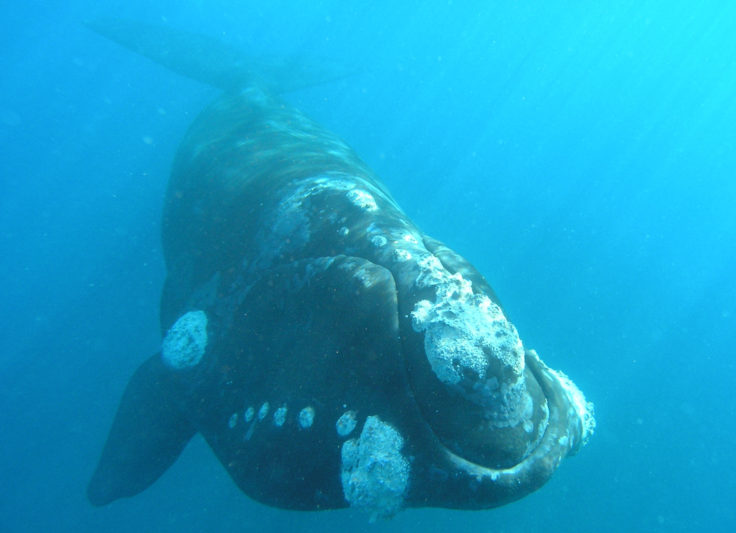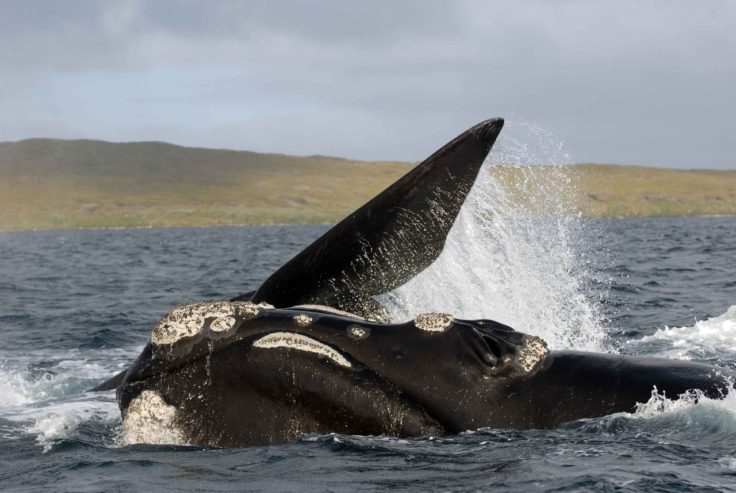PRESS RELEASE: Assessment of whales’ decline
Research shows extent of decline of New Zealand southern right whales
The first population assessment since the end of the whaling era reveals that New Zealand southern right whales have some way to go before numbers return to pre-industrial levels. Reporting this week in Royal Society Open Science scientists from British Antarctic Survey (BAS), the University of Auckland, Oregon State University and the University of St Andrews, explain how they used historic logbook records from whaling ships and computer modelling to compare population numbers.
The New Zealand southern right whale was particularly exploited in the nineteenth century when demand was high for oil extracted from its blubber. They were killed on the high seas and especially in sheltered bays where females were vulnerable while caring for their young calves. So it was easy for people to row out from the shore and kill them and for whale ships to hunt them on the open ocean. The term “right whale” was coined because they were so easy to hunt.

This latest research used current estimates of abundance and population increase to reconstruct the population’s trajectory over time. The findings suggest that between 29,000 and 47,000 whales were killed before the end of the nineteenth century. Numbers fell to roughly one hundred animals at the start of the twentieth century. Estimates vary as to how many may have been killed. This latest research suggests there were between 29,000 and 47,000 before the nineteenth century and that this fell to a paltry 100 animals between 1914 and 1926. Today levels stand at less than 12 per cent of pre-industrial levels.
Lead author, Jennifer Jackson, of BAS:
“We estimate that prior to whaling, southern right whales were very abundant in New Zealand waters and numbered between 28,000 and 33,000. If we assume most catches in the south-west Pacific were of New Zealand right whales, this number rises to 47,000. To put this in context, the estimated size of the current New Zealand population is less than 12% of these numbers. The road to recovery for this species is proving to be long – we estimate it will be at least 60 years before this population is restored to pre-hunting numbers.”
Emma Carroll of the University of St Andrews says:
“The records of whale catches from the early nineteenth century are very patchy and we really needed to do a bit of detective work to get a good insight into the whaling history. We went back through early colonial New Zealand historical records, whaling logbooks and even had to cross-reference what ships had been seen where to get an understanding of the scale of operations during the winter in New Zealand. This has given a good insight into whaling history in New Zealand and made this population assessment possible.”

Historical whaling records used in this research were compiled by the World Whaling History Project, which summarised records American whaling logbook and New Zealand government records from 1800 to the present as part of the History of Marine Animal Populations and Census of Marine Life (CoML.org) initiatives.
The research will be of vital importance in the planning of conservation strategies for this species and for the future protection of their habitats.
ENDS
Issued by the British Antarctic Survey Press Office:
The paper “An integrated approach to historical population assessment of the great whales: case of the New Zealand southern right whale” by Jennifer Jackson, Emma Carroll, Tim Smith, Alexandre Zerbini, Nathalie Patenaude and C Scott Baker, is published by Royal Society Open Science: http://rsos.royalsocietypublishing.org/lookup/doi/10.1098/rsos.150669.
Notes for editors:
The research was funded by the New Zealand Ministry of Fisheries, an Oregon State University General Research Fund, the Pew Charitable Trust, the Royal Society of New Zealand and the Natural Environment Research Council (NERC).